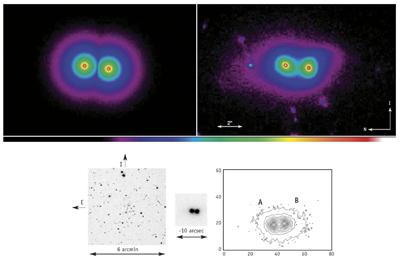Spaghetti of the universe

Cosmic strings are topological errors. When the universe was very young, there were transitions of cosmological phase that could lead to errors and that are cosmic strings.
Let's try to understand it with an analogy: suppose one of the transition phases of the universe is something equivalent to the conversion of liquid water into ice. Therefore, at high temperatures we would have liquid water and when the temperature drops the water would become ice. But it is possible (according to the theory we use) that streams of liquid water appear inside the ice. If this happened, those who live in a cold phase (ice), we can observe how the warm phase was observing these streams. These streams are analogous to the defects, the fragments of high temperature (streams) that have remained in the phase of low temperature (ice).
Very high energies
The errors that predict high-energy cosmological models have, in most cases, rope form, that is, they are one-dimensional objects. In addition, they have incredible properties: although they have a much smaller width than that of an atom (perhaps the width of a proton), the length is measured in light years (they extend throughout the entire universe). The mass is also huge: a one kilometer rope would have the same mass as Earth! It may be helpful to have a normal mental image: the cosmic strings are similar to those of very long spaghetti, very fine and of great mass.
In cosmology it is very difficult to detect errors and, in some way, they are only known in the theoretical field. But in other areas of physics, errors occur. In the physics of condensed matter, for example, defects appear in liquid crystals, ferromagnetic materials, superconductors, etc. These errors can be analyzed in laboratory, which allows an interesting relationship between condensed matter and cosmology. In any case, although they have not been seen in cosmology, it is quite logical to think that errors can be in the universe, since they exist in other areas of physics.
Cosmic strings are possible in many high energy theories, including the theory of superstrings (thus, although with totally different concepts, superstrings and cosmic strings have some links). And, if they appeared, they would appear in a very high energy, much higher than what can be obtained in particle accelerators. Finding strings would be a great advance for basic physics. For many, cosmic strings are one of the few possibilities to directly test the theory of superstrings.

But, as we have said, it is very difficult to observe directly the cosmic strings. Imagine that the cosmic strings were formed in the newborn universe. At that time the universe seemed to spin a plate. But as the universe cools down and grows, the string density was decreasing. Now only a few spaghetti are on our plate (our observable universe). Being close to us is a very unlikely fact. Therefore, instead of directly measuring the strings, we should measure their indirect effects, for example by means of the effect of the strings on the microwave background radiation (CMB) or by the effect of the gravitational lens.
Indirect evidence
The gravitational lens is a phenomenon known in astrophysics: if there is an object of great mass between a galaxy far from us and us (for example, a group of galaxies), the light of the distant galaxy deteriorates as a consequence of that intermediate object and the image is distorted. The analysis of the distortion allows to deduce the properties of the central object with mass. Likewise, if there were a cosmic cord between the remote galaxy and us, the image would be distorted, but the distortion produced by the strings and the distortion caused by any other mass are different. In the case of the normal effect of the gravitational lens (produced by high-mass astrophysical objects, such as clusters of galaxies), numerous images of a single remote object will appear, usually in the form of a ring or arc. In the case of the gravitational lens effect that the strings will produce, multiple images of the remote object will also occur, but, unlike in the other case, all images will have the same aspect, as if they were repeated.
This is what they saw when they observed the object called CSL-1 (Capodimonte-Stenberg-Lens, 1st candidate): two galaxies very similar to each other. To explain an object of this type, there are only two possibilities: the effect of the gravitational lens produced by a cosmic cord (therefore, two identical images of a single galaxy), or that two galaxies with very similar properties (both in photometry and in spectroscopy) are together (from our point of view). Both options are very unlikely and to know the actual response, more accurate observations were made. When the Hubble Telescope observed the CSL-1, it observed that both images were not exactly the same. It was not a string, but two similar galaxies. The team that found the CSL-1 is still looking for more objects of this type, hoping to find a rope.

The other possibility we have mentioned is CMB, microwave background radiation. The CMB is very homogeneous, but it has some anisotropies, some granules. These grains, although small, have been measured in cosmological experiments. We know the paradigm that explains very well the anisotropy: inflation. According to inflation, the universe grew exponentially in the short term. But it can also be the formation of cosmic strings at the end of inflation. By moving the strings through the universe they will provoke perturbations and attract matter. These perturbations will also form anisotropy, in addition to anisotropy generated by inflation. If there were cosmic strings, we could measure these "extra" perturbations generated in the CMB and detect the strings indirectly.
The cmb anisotropies that would generate cosmic strings can be simulated by supercomputers and compared with the temperature anisotropies of CMB measured by cosmological experiments. Take the best available cosmological data, such as those provided by WMAP. Using inflation models, we try to adjust the data as best as possible. Now, taking into account also the extra perturbations generated by the strings, we will also adjust the data. Through this analysis, numerical experiments tell us that if we take into account cosmic strings, we can better explain the data. We cannot say with certainty that we have found strings. In addition, with other cosmological data (in addition to the CMB) the existence of strings is not so evident. We need new and more accurate data. Perhaps the Planck satellite that took off in May will help us. Planck will measure the CMB with great precision, both temperature anisotropy and polarization anisotropy. Other experiments will also perform new measurements.

But in any case, with the current data, we can affirm that the data do not say that there are no strings. And the simple detection of strings is very important. If the new data makes it clear that the strings were not formed, we will have to discard some cosmological models and, perhaps, create new models. On the other hand, if we can observe the strings, we will see the relics of the newborn universe, a unique opportunity to see how the newborn universe was.






